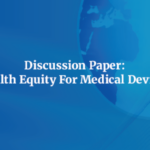Nearly half of Americans with health insurance report receiving unexpected medical bills or charges for services that should have been covered, pointing to a systemic issue in the healthcare system.(1) This problem is widespread and financially devastating, with errors in medical billing costing Americans $210 billion annually and contributing to $68 billion in unnecessary healthcare expenses.(2) Adding to the financial strain, the complexity of the billing process leaves many consumers unaware that such charges can be contested, creating confusion around who is responsible, and diminishing confidence in the care process.(3)
However, the integration of artificial intelligence (AI) and machine learning (ML) is transforming the healthcare industry, making it smarter, more efficient, and more accessible. These technologies help reduce errors, enhance transparency, and restore trust in medical services. Complemented by human oversight — healthcare professionals reviewing and validating AI processes — together they ensure accuracy, address nuanced cases, and maintain ethical standards in patient care.(4)
The Hidden Factors Behind Medical Billing Errors
Persistent errors in medical billing often result from a combination of human, technological, and procedural factors. Key contributors include:
- Data Entry and Documentation Errors: Inaccurate or incomplete patient demographics often lead to billing errors. Manual data entry, with lower precision than automated systems, is prone to mistakes. Automation, in contrast, can achieve up to 99.99% accuracy, significantly reducing errors.(5) Messy or unclear documentation from healthcare providers can make it difficult for billers and coders to input correct data.
- Coding Issues: Incorrect or outdated coding practices, such as entering the wrong Current Procedural Terminology (CPT) or International Classification of Diseases (ICD) significantly contribute to billing errors. Errors such as missing or incorrect CPT, point-of-service, or ICD-10 codes can create significant billing issues, sometimes leading to inflated charges or incomplete billing for services provided.(6)
- Duplicate Billing: This error occurs when services are mistakenly billed more than once, either due to a lack of coordination between departments or improper cross-checking.(7) Double billing can severely impact both healthcare providers and patients, as it forces consumers to pay for services already covered by insurance.
AI’s Transformative Potential in Claims Processing and Medical Coding
AI and machine learning technologies have the potential to drastically transform medical claims processing and coding, offering several key advantages, including reducing errors, improving efficiency, and enhancing patient experiences.
Breakdown of benefits
Real-Time Error Detection Boosts Claims Processing Efficiency:
AI-powered autonomous coding systems are revolutionizing the way medical claims are processed by significantly reducing errors in coding and billing. These systems automatically generate accurate codes from clinical documentation, eliminating the need for manual input and minimizing human error. By processing large volumes of data in seconds, AI ensures claims are submitted correctly the first time, streamlining the billing process. A recent study highlighted that AI-driven coding systems have reduced coding errors by up to 35%, showcasing their potential to transform the healthcare industry by improving billing accuracy and operational efficiency.(8)
Moreover, AI’s ability to detect discrepancies and inconsistencies in real time enhances financial health by proactively flagging issues before claims are submitted. This proactive approach reduces claim denials by up to 20%, improving reimbursement rates and ensuring that healthcare providers are paid promptly.(9) By minimizing coding errors and ensuring accurate reimbursement, AI also alleviates the emotional distress patients experience from rejected claims, making the overall experience smoother for providers and patients.
Clinical Documentation and Revenue Cycle Management Optimization with NLP:
Natural Language Processing (NLP) is transforming clinical documentation and revenue cycle management by leveraging advanced algorithms to analyze extensive data from clinical notes and patient records. This enables AI tools to accurately extract relevant information and generate detailed reports, significantly reducing human error.(5) With speech recognition and the ability to adapt to various writing styles, NLP enhances documentation quality, achieving transcription accuracy rates of up to 95% and cutting documentation time by 70%–90%.(9)
Furthermore, this tool can optimize revenue cycle workflows by simplifying processes and reducing manual intervention. Machine learning models can prioritize claims based on their likelihood of approval, ensuring high-priority cases receive timely attention.(10) This approach speeds up claims processing and lowers administrative overhead, allowing clinicians to focus on what matters: their patient’s care and outcomes.
Enhancing Diagnostic Accuracy:
Misdiagnosis occurs in approximately 15% to 20% of medical encounters, often due to doctors overlooking subtle signs or encountering conditions that do not align with textbook illness scripts.(11) Errors can happen when scripts are misread or present atypical factors. Furthermore, some doctors may misdiagnose because they cannot find the correct code or face time restrictions. Also, they may not add all applicable codes for a patient or might not put them in the correct order. AI can assist healthcare professionals through advanced pattern recognition, improving diagnostic precision and speed. Studies reveal that AI can detect ischemic strokes tens of minutes faster than a radiologist.(12)
In addition, it can detect conditions like hypertrophic cardiomyopathy (HCM) early. A recent study from UC San Francisco demonstrates that AI-enhanced Electrocardiograms (ECGs) can identify HCM in its earliest stages and track disease-related changes over time.(13) By identifying these conditions early, healthcare professionals can prevent costly misdiagnoses and late-stage interventions.
Human Oversight: Key to Ensuring Precision and Safety in AI-Enhanced Diagnostics and Billing
As AI and ML continue to transform healthcare, their potential is undeniable. However, they must be complemented with human oversight to ensure responsible use, and precision, prioritizing patient safety.
Human-in-the-loop Machine Learning (HITL/ML) systems, where human expertise validates and supervises AI decision-making, play a crucial role in achieving this balance.(14) While AI excels in pattern recognition and streamlining administrative processes, human oversight ensures that the essence of patient care and complex medical scenarios are not lost.
AI’s integration into healthcare workflows can significantly reduce errors — both in diagnostics and in medical billing — leading to more accurate claims and improved patient outcomes. Human oversight does more than just catch anomalies or mistakes; it actively assists machine learning to prevent these mistakes from occurring in the future, enhancing AI for future iterations. While many solutions claim to have HITL/ML processes, it is vital to consider who exactly makes up the ‘human’ in the loop. Third-party credentialing teams should take on this role; doctors should be supported by these teams so they can practice at the top of their license, focusing on what matters most: the patient.
Healthcare providers were trained to treat — not to type, code, or bill. While AI can assist by processing vast amounts of data and identifying patterns, it should not place additional administrative burdens on doctors. Instead, physicians should leverage their expertise to provide critical judgment, empathy, and understanding in interpreting complex cases and connecting with patients. By reserving these essential skills for direct patient care, doctors can ensure better outcomes while allowing third-party experts to manage administrative processes.
Responsible AI use ensures that technology serves as a powerful tool to enhance care, but always under the guidance of professionals who make informed decisions. This way, the future of healthcare innovation lies not in the replacement of human workers, but in the complement of human skills with AI capabilities, ensuring that advancements in efficiency, error reduction, and diagnostics always align with the highest standards of patient care and safety.
References
- Gibson, Kate. “Nearly Half of Insured Americans Get Surprise Expenses in Medical Bills, Study Finds.” com, CBS News, Aug. 2024, www.cbsnews.com/news/medical-bills-denied-coverage-health-insurance-commonwealth-fund/.
- Lindner, Jannik. “Study Reveals Shocking Medical Billing Errors Statistics Impacting Americans.” org, 17 July 2024, gitnux.org/medical-billing-errors-statistics/.
- EU Artificial Intelligence Act. “Article 14: Human Oversight.” EU Artificial Intelligence Act, EU Artificial Intelligence Act, artificialintelligenceact.eu/article/14/.
- Martinez, Jorge. “67 Data Entry Statistics for 2024.” DocuClipper, 1 Mar. 2024, docuclipper.com/blog/data-entry-statistics/.
- Medical Billers and Coders. “Reasons for Persistent Errors in Medical Billing.” MBC Medical Billing and Coding Blogs, 8 Jan. 2016, medicalbillersandcoders.com/blog/reasons-for-persistent-errors-in-medical-billing/. Accessed 8 Nov. 2024.
- Consumer Financial Protection Bureau. “CFPB Takes Aim at Double Billing and Inflated Charges in Medical Debt Collection | Consumer Financial Protection Bureau.” Consumer Financial Protection Bureau, Oct. 2024, consumerfinance.gov/about-us/newsroom/cfpb-takes-aim-at-double-billing-and-inflated-charges-in-medical-debt-collection/. Accessed 8 Nov. 2024.
- John, Robert. “AI in Medical Coding: Transforming Healthcare with Cutting-Edge Technologies in 2024.” Medium, AI Logic, 16 Sept. 2024, medium.com/ailogic/ai-in-medical-coding-transforming-healthcare-with-cutting-edge-technologies-in-2024-bbdbb6aeded4. Accessed 8 Nov. 2024.
- Ulrich, Austin. “8 Best AI Medical Documentation Tools for Healthcare in 2024.” Austin Ulrich, 28 Feb. 2023, austinulrich.com/best-ai-medical-documentation-tools-for-healthcare.
- Kovalenko, Paul. “Claim Denial Prediction: Harnessing AI for Healthcare Revenue Cycle Management.” Forbes, 6 Sept. 2024, forbes.com/councils/forbestechcouncil/2024/09/06/claim-denial-prediction-harnessing-ai-for-healthcare-revenue-cycle-management/.
- Balogh, Erin P, et al. “Improving Diagnosis in Health Care.” National Library of Medicine (NIH), National Academies Press (US), 29 Dec. 2019, ncbi.nlm.nih.gov/books/NBK338594/.
- Lovell, Ariane. “Large Real-World, Multi-Center Study Demonstrates Viz.ai Platform Saves Critical Minutes in Stroke Care.” ai, the Proven AI-Powered Care Coordination Platform, 8 Feb. 2023, www.viz.ai/news/large-real-world-multi-center-study-demonstrates-viz-ai-platform-saves-critical-minutes-in-stroke-care.
- Krigel, Melinda. “Using AI in Electrocardiogram Analysis Can Improve Diagnosis and Treatment of Hypertrophic Cardiomyopathy.” Using AI in Electrocardiogram Analysis Can Improve Diagnosis and Treatment of Hypertrophic Cardiomyopathy | UC San Francisco, 7 Mar. 2022, ucsf.edu/news/2022/03/422396/using-ai-electrocardiogram-analysis-can-improve-diagnosis-and-treatment#main-content. Accessed 8 Nov. 2024.
- Google Cloud. “What Is Human in the Loop.” Google Cloud, cloud.google.com/discover/human-in-the-loop.







